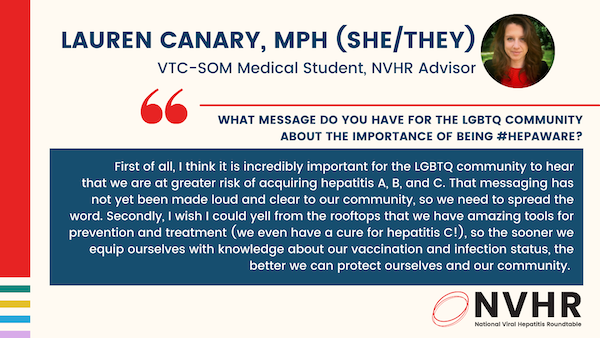
As a part of Pride Month, NVHR is celebrating the contributions the LGBTQ community has made in raising awareness for viral hepatitis, HIV, and other health concerns that disproportionately impact LGBTQ people. NVHR recently sat down with Lauren Canary, Viral Hepatitis Epidemiologist and former NVHR Director, to discuss opportunities to advance public health programs and increase awareness of viral hepatitis among the LGBTQ community. Lauren Canary, MPH (she/they) is a Virginia Tech Carilion School of Medicine medical student and an NVHR Advisor.
NVHR: June 5th marked the 40th anniversary of the nation’s first reported cases of AIDS. What can the hepatitis community glean from HIV advocacy by the LGBTQ community in our fight towards eliminating viral hepatitis?
LC: The HIV/AIDS advocacy movement has, from the outset, elevated the voices of those individuals with lived experience, and particularly those LGBTQ-identifying individuals facing intersectional stigma associated not just with their infection status, but also their sexual and gender identities. I think we can do much better in this regard in our movement to eliminate viral hepatitis—many of the members of our community who face stigma associated with their infection status and their intersectional identities are functionally silenced by societal structures and criminalization. I think once we center their experiences and bring viral hepatitis awareness to every household and every lawmaker’s office, we will have more political momentum and, frankly, better programs and policies.
NVHR: Our public health surveillance systems often erase the LGBTQ community. What needs to happen for us to understand the impact that hepatitis has in this community?
LC: Surveillance is the cornerstone of public health, and until we count LGBTQ individuals we will be underestimating disease burden and creating programs that are ill-informed to reach these individuals. We must partner with LGBTQ-individuals to design tools to reach our community members, particularly those who may face significant barriers with disclosing their sexual or gender identities. Additionally, we may (at least until we have more funding) need to sacrifice quantity for quality. I think for the purposes of health equity, it is better to do a really good job at capturing information about identity (LGBTQ or otherwise) from a smaller number of people than to get limited information about identity from as many cases as possible. We have brilliant statisticians who can help us estimate national prevalence from smaller numbers, but they cannot tell us what is happening in marginalized communities. As we invest in public health surveillance we must make this intention around health equity clear from the outset.
NVHR: We’ve made progress in raising awareness about hepatitis among various communities, but more work remains. What are some ideas of ways to raise awareness about hepatitis in the LGBTQ community?
LC: Every time I am at Pride festivals I see brilliant, well-funded HIV messaging and testing opportunities. I would LOVE to see more awareness around viral hepatitis (A, B, & C) at Pride celebrations. I think it would be an easy lift for our industry partners who are already at these festivals and could be really helpful at bringing conversations about viral hepatitis out of the doctor’s office and into the community in a laid back, fun setting.
NVHR: What message do you have for the LGBTQ community about the importance of being #HepAware?
LC: First of all, I think it is incredibly important for the LGBTQ community to hear that we are at greater risk of acquiring hepatitis A, B, and C. That messaging has not yet been made loud and clear to our community, so we need to spread the word. Secondly, I wish I could yell from the rooftops that we have amazing tools for prevention and treatment (we even have a cure for hepatitis C!), so the sooner we equip ourselves with knowledge about our vaccination and infection status, the better we can protect ourselves and our community.